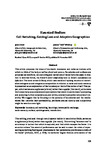Haunted Bodies: Cell Switching, Getting Lost and Adaptive Geographies
| dc.contributor.author | Grant, Jane | |
| dc.contributor.author | Whalley, J | |
| dc.date.accessioned | 2021-09-21T12:12:46Z | |
| dc.date.available | 2021-09-21T12:12:46Z | |
| dc.date.issued | 2017-11-21 | |
| dc.identifier.issn | 2082-6710 | |
| dc.identifier.issn | 2082-6710 | |
| dc.identifier.uri | http://hdl.handle.net/10026.1/17906 | |
| dc.description.abstract |
This article proposes the ideas of stochastic resonance and noise as devices with which to think of the body or self as plural and porous. Boundaries and surfaces are proposed as indefinite; cell switching and narratives of the self are discussed in relation to external forces, via Arendt's inter-subjectivity and La Celca's colonization as infection. The sonic artwork Ghost, which uses models of spiking neurons to materialize endogenous and exogenous composition in relation to noise and sonic memory is presented as an exploration of the boundary or limit of the notion of self. This paper, which serves as a cogitatum (a force) rather than cognitio (the result), articulates the human body as a complex and open system that steers towards chaos by adapting and accepting further complexity as, and within, constantly adaptive networks of creativity. We suggest that by focusing on the porosity of boundaries and the mechanisms that underlie their permeability, problems around identity and subjectivity might be seen in a new light. | |
| dc.format.extent | 273-283 | |
| dc.language.iso | en | |
| dc.publisher | The Centre for Philosophical Research | |
| dc.title | Haunted Bodies: Cell Switching, Getting Lost and Adaptive Geographies | |
| dc.type | journal-article | |
| dc.type | Journal Article | |
| plymouth.issue | Special | |
| plymouth.volume | VIII | |
| plymouth.publication-status | Published online | |
| plymouth.journal | AVANT. The Journal of the Philosophical-Interdisciplinary Vanguard | |
| dc.identifier.doi | 10.26913/80s02017.0111.0025 | |
| plymouth.organisational-group | /Plymouth | |
| plymouth.organisational-group | /Plymouth/Faculty of Arts, Humanities and Business | |
| plymouth.organisational-group | /Plymouth/REF 2021 Researchers by UoA | |
| plymouth.organisational-group | /Plymouth/REF 2021 Researchers by UoA/UoA32 Art and Design: History, Practice and Theory | |
| plymouth.organisational-group | /Plymouth/Users by role | |
| plymouth.organisational-group | /Plymouth/Users by role/Academics | |
| dcterms.dateAccepted | 2017-10-05 | |
| dc.rights.embargodate | 2021-9-22 | |
| dc.identifier.eissn | 2082-6710 | |
| dc.rights.embargoperiod | Not known | |
| rioxxterms.versionofrecord | 10.26913/80s02017.0111.0025 | |
| rioxxterms.licenseref.uri | http://www.rioxx.net/licenses/all-rights-reserved | |
| rioxxterms.licenseref.startdate | 2017-11-21 | |
| rioxxterms.type | Journal Article/Review |


